Financial Accounting: Qualitative Characteristics and Materiality
VerifiedAdded on 2021/04/16
|6
|1347
|146
Report
AI Summary
This report delves into the concept of materiality within the framework of advanced financial accounting. It begins by defining materiality as a key aspect of relevance, emphasizing its role in influencing the decisions of financial statement users. The report references IAS 1 and IAS 8 to underscore the importance of data that can alter user decisions. It then examines the IFRS Practice Statement 2 and Exposure Draft on materiality, detailing the characteristics, including definition, pervasiveness, and the role of judgment. The report outlines the four-step process for making materiality judgments, covering specific situations like prior period information and errors. It also touches upon the amendments to IAS 1 and IAS 8, which aim to clarify the definition of materiality. The report concludes by highlighting the benefits of these initiatives, such as improved accountant judgment and enhanced decision-making for stakeholders.
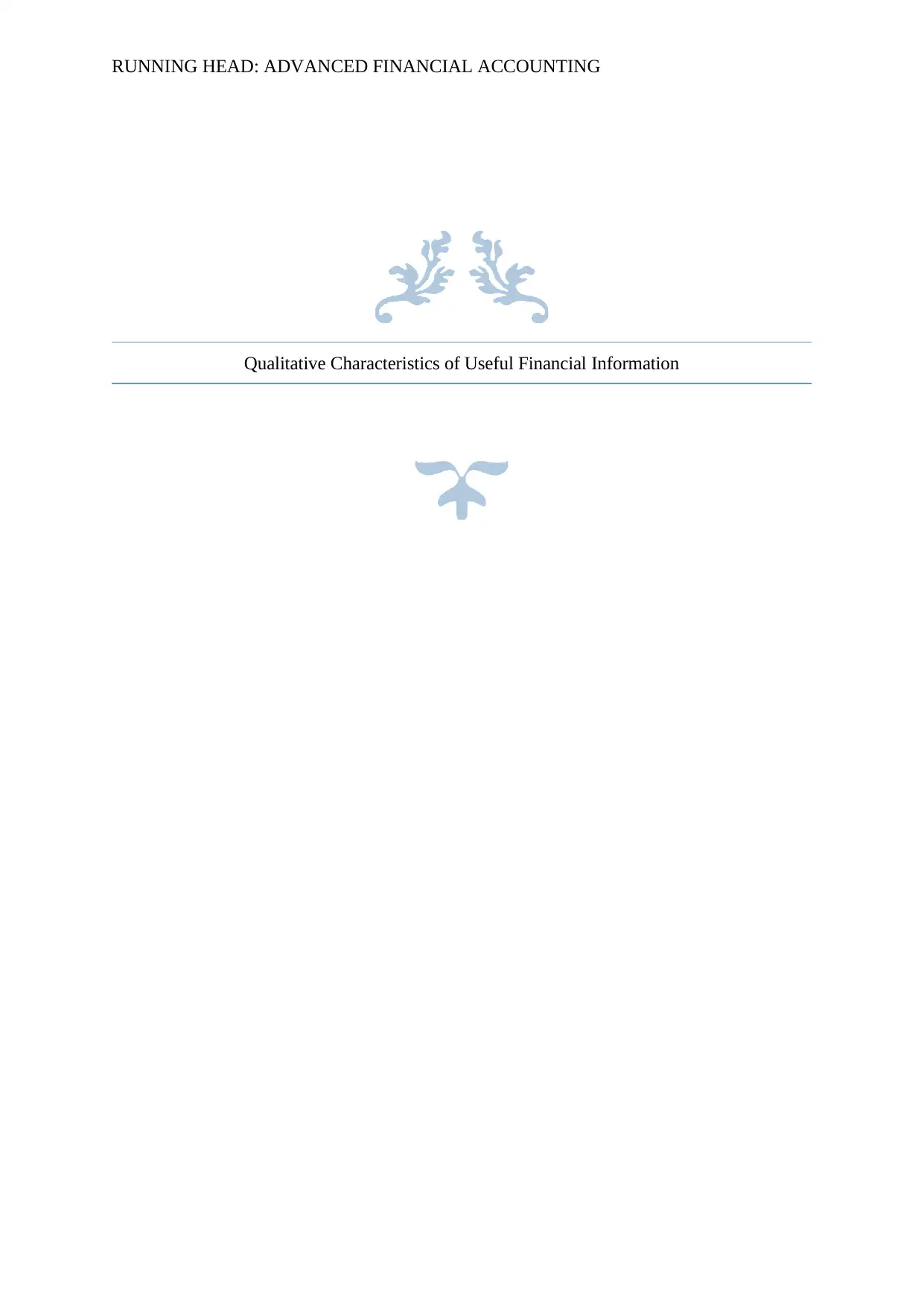
RUNNING HEAD: ADVANCED FINANCIAL ACCOUNTING
Qualitative Characteristics of Useful Financial Information
Qualitative Characteristics of Useful Financial Information
Paraphrase This Document
Need a fresh take? Get an instant paraphrase of this document with our AI Paraphraser
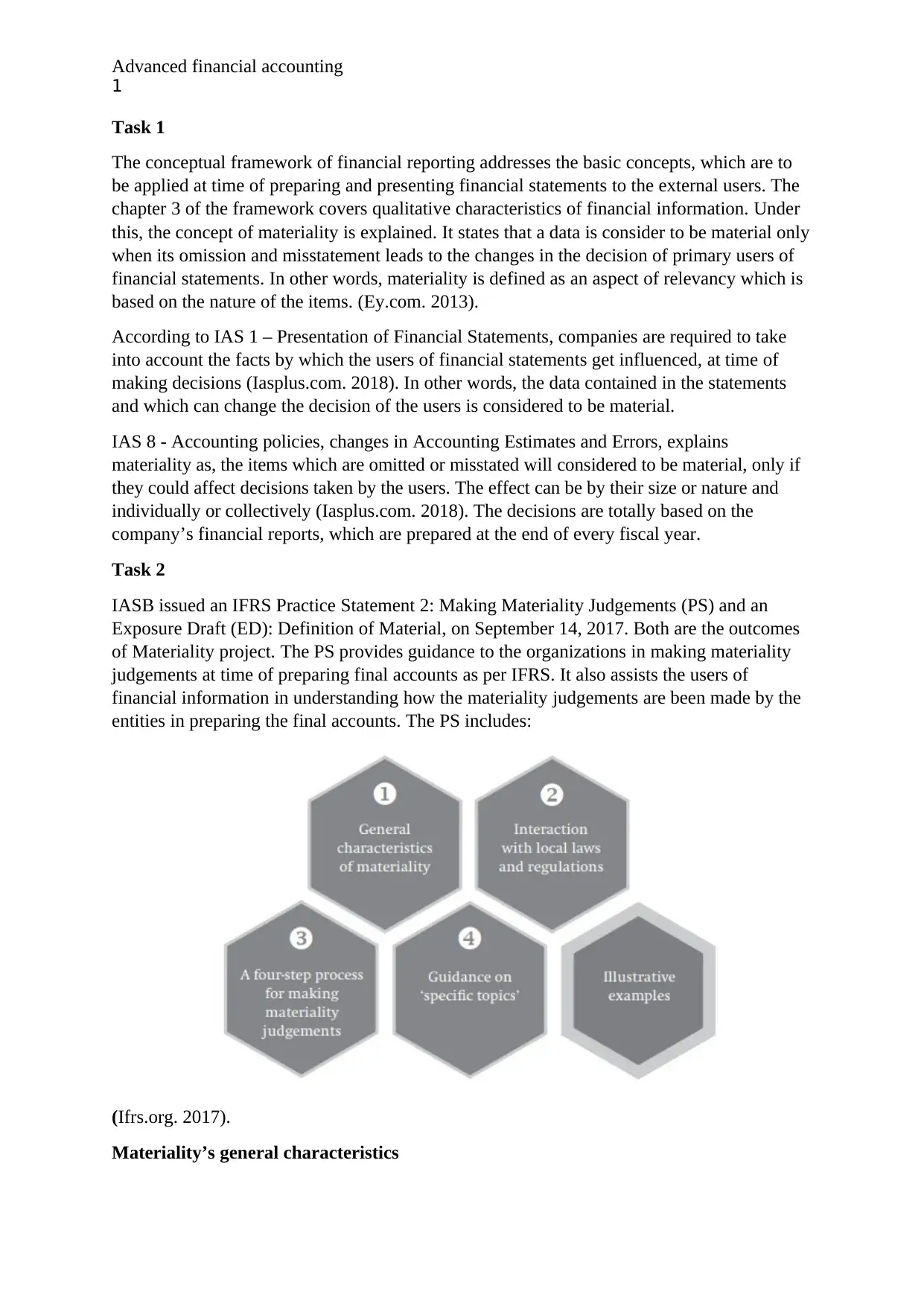
Advanced financial accounting
1
Task 1
The conceptual framework of financial reporting addresses the basic concepts, which are to
be applied at time of preparing and presenting financial statements to the external users. The
chapter 3 of the framework covers qualitative characteristics of financial information. Under
this, the concept of materiality is explained. It states that a data is consider to be material only
when its omission and misstatement leads to the changes in the decision of primary users of
financial statements. In other words, materiality is defined as an aspect of relevancy which is
based on the nature of the items. (Ey.com. 2013).
According to IAS 1 – Presentation of Financial Statements, companies are required to take
into account the facts by which the users of financial statements get influenced, at time of
making decisions (Iasplus.com. 2018). In other words, the data contained in the statements
and which can change the decision of the users is considered to be material.
IAS 8 - Accounting policies, changes in Accounting Estimates and Errors, explains
materiality as, the items which are omitted or misstated will considered to be material, only if
they could affect decisions taken by the users. The effect can be by their size or nature and
individually or collectively (Iasplus.com. 2018). The decisions are totally based on the
company’s financial reports, which are prepared at the end of every fiscal year.
Task 2
IASB issued an IFRS Practice Statement 2: Making Materiality Judgements (PS) and an
Exposure Draft (ED): Definition of Material, on September 14, 2017. Both are the outcomes
of Materiality project. The PS provides guidance to the organizations in making materiality
judgements at time of preparing final accounts as per IFRS. It also assists the users of
financial information in understanding how the materiality judgements are been made by the
entities in preparing the final accounts. The PS includes:
(Ifrs.org. 2017).
Materiality’s general characteristics
1
Task 1
The conceptual framework of financial reporting addresses the basic concepts, which are to
be applied at time of preparing and presenting financial statements to the external users. The
chapter 3 of the framework covers qualitative characteristics of financial information. Under
this, the concept of materiality is explained. It states that a data is consider to be material only
when its omission and misstatement leads to the changes in the decision of primary users of
financial statements. In other words, materiality is defined as an aspect of relevancy which is
based on the nature of the items. (Ey.com. 2013).
According to IAS 1 – Presentation of Financial Statements, companies are required to take
into account the facts by which the users of financial statements get influenced, at time of
making decisions (Iasplus.com. 2018). In other words, the data contained in the statements
and which can change the decision of the users is considered to be material.
IAS 8 - Accounting policies, changes in Accounting Estimates and Errors, explains
materiality as, the items which are omitted or misstated will considered to be material, only if
they could affect decisions taken by the users. The effect can be by their size or nature and
individually or collectively (Iasplus.com. 2018). The decisions are totally based on the
company’s financial reports, which are prepared at the end of every fiscal year.
Task 2
IASB issued an IFRS Practice Statement 2: Making Materiality Judgements (PS) and an
Exposure Draft (ED): Definition of Material, on September 14, 2017. Both are the outcomes
of Materiality project. The PS provides guidance to the organizations in making materiality
judgements at time of preparing final accounts as per IFRS. It also assists the users of
financial information in understanding how the materiality judgements are been made by the
entities in preparing the final accounts. The PS includes:
(Ifrs.org. 2017).
Materiality’s general characteristics
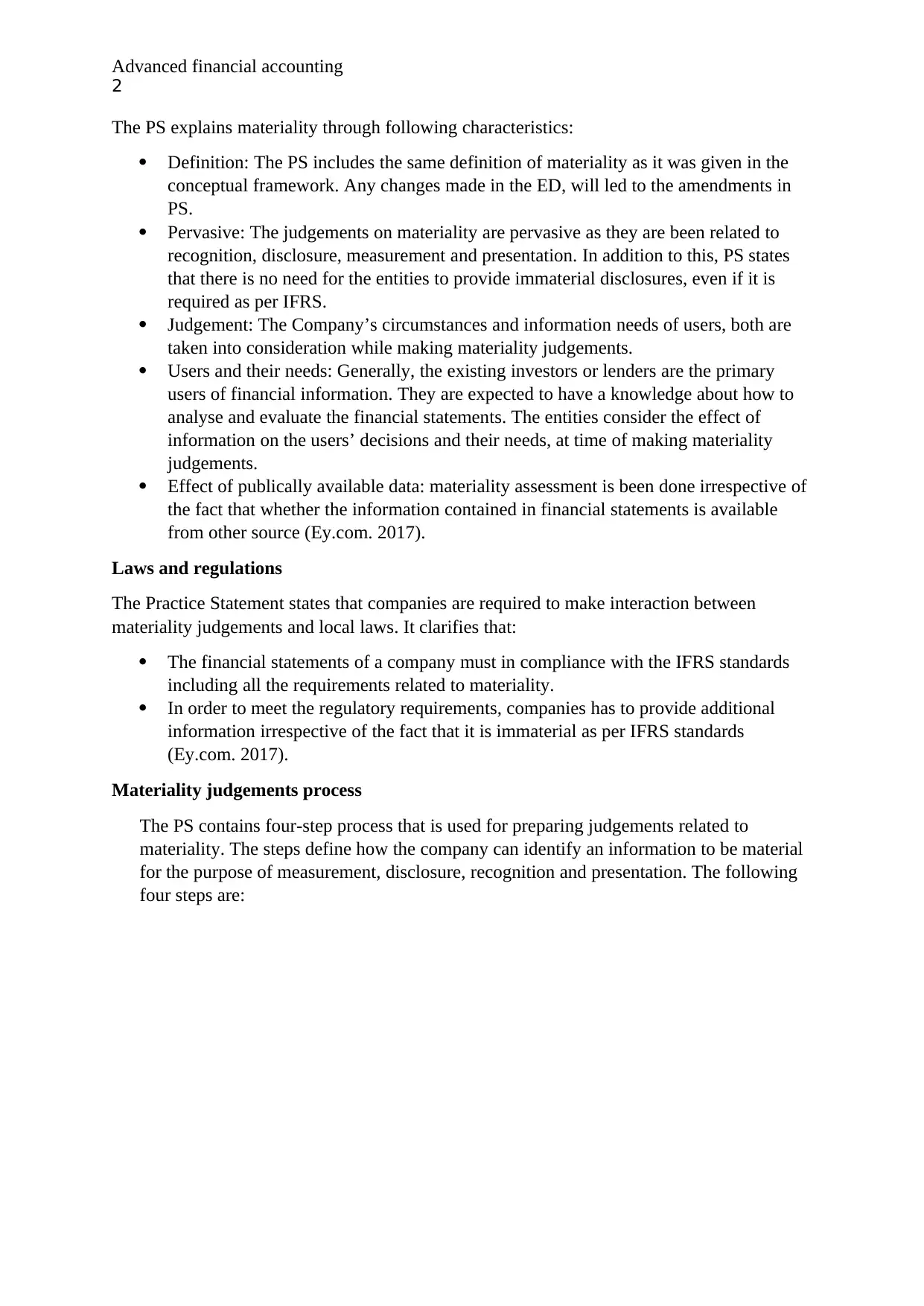
Advanced financial accounting
2
The PS explains materiality through following characteristics:
Definition: The PS includes the same definition of materiality as it was given in the
conceptual framework. Any changes made in the ED, will led to the amendments in
PS.
Pervasive: The judgements on materiality are pervasive as they are been related to
recognition, disclosure, measurement and presentation. In addition to this, PS states
that there is no need for the entities to provide immaterial disclosures, even if it is
required as per IFRS.
Judgement: The Company’s circumstances and information needs of users, both are
taken into consideration while making materiality judgements.
Users and their needs: Generally, the existing investors or lenders are the primary
users of financial information. They are expected to have a knowledge about how to
analyse and evaluate the financial statements. The entities consider the effect of
information on the users’ decisions and their needs, at time of making materiality
judgements.
Effect of publically available data: materiality assessment is been done irrespective of
the fact that whether the information contained in financial statements is available
from other source (Ey.com. 2017).
Laws and regulations
The Practice Statement states that companies are required to make interaction between
materiality judgements and local laws. It clarifies that:
The financial statements of a company must in compliance with the IFRS standards
including all the requirements related to materiality.
In order to meet the regulatory requirements, companies has to provide additional
information irrespective of the fact that it is immaterial as per IFRS standards
(Ey.com. 2017).
Materiality judgements process
The PS contains four-step process that is used for preparing judgements related to
materiality. The steps define how the company can identify an information to be material
for the purpose of measurement, disclosure, recognition and presentation. The following
four steps are:
2
The PS explains materiality through following characteristics:
Definition: The PS includes the same definition of materiality as it was given in the
conceptual framework. Any changes made in the ED, will led to the amendments in
PS.
Pervasive: The judgements on materiality are pervasive as they are been related to
recognition, disclosure, measurement and presentation. In addition to this, PS states
that there is no need for the entities to provide immaterial disclosures, even if it is
required as per IFRS.
Judgement: The Company’s circumstances and information needs of users, both are
taken into consideration while making materiality judgements.
Users and their needs: Generally, the existing investors or lenders are the primary
users of financial information. They are expected to have a knowledge about how to
analyse and evaluate the financial statements. The entities consider the effect of
information on the users’ decisions and their needs, at time of making materiality
judgements.
Effect of publically available data: materiality assessment is been done irrespective of
the fact that whether the information contained in financial statements is available
from other source (Ey.com. 2017).
Laws and regulations
The Practice Statement states that companies are required to make interaction between
materiality judgements and local laws. It clarifies that:
The financial statements of a company must in compliance with the IFRS standards
including all the requirements related to materiality.
In order to meet the regulatory requirements, companies has to provide additional
information irrespective of the fact that it is immaterial as per IFRS standards
(Ey.com. 2017).
Materiality judgements process
The PS contains four-step process that is used for preparing judgements related to
materiality. The steps define how the company can identify an information to be material
for the purpose of measurement, disclosure, recognition and presentation. The following
four steps are:
⊘ This is a preview!⊘
Do you want full access?
Subscribe today to unlock all pages.

Trusted by 1+ million students worldwide
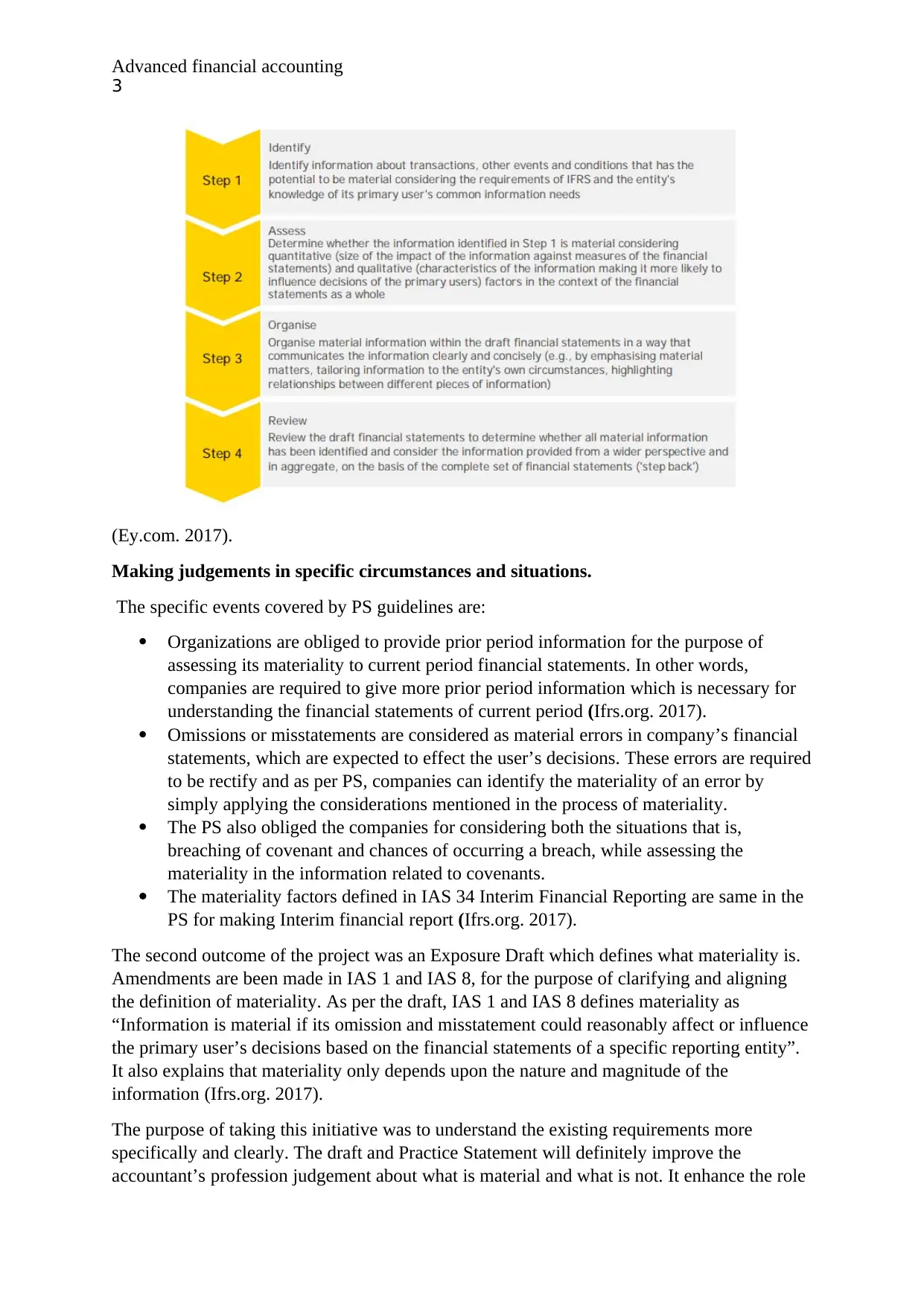
Advanced financial accounting
3
(Ey.com. 2017).
Making judgements in specific circumstances and situations.
The specific events covered by PS guidelines are:
Organizations are obliged to provide prior period information for the purpose of
assessing its materiality to current period financial statements. In other words,
companies are required to give more prior period information which is necessary for
understanding the financial statements of current period (Ifrs.org. 2017).
Omissions or misstatements are considered as material errors in company’s financial
statements, which are expected to effect the user’s decisions. These errors are required
to be rectify and as per PS, companies can identify the materiality of an error by
simply applying the considerations mentioned in the process of materiality.
The PS also obliged the companies for considering both the situations that is,
breaching of covenant and chances of occurring a breach, while assessing the
materiality in the information related to covenants.
The materiality factors defined in IAS 34 Interim Financial Reporting are same in the
PS for making Interim financial report (Ifrs.org. 2017).
The second outcome of the project was an Exposure Draft which defines what materiality is.
Amendments are been made in IAS 1 and IAS 8, for the purpose of clarifying and aligning
the definition of materiality. As per the draft, IAS 1 and IAS 8 defines materiality as
“Information is material if its omission and misstatement could reasonably affect or influence
the primary user’s decisions based on the financial statements of a specific reporting entity”.
It also explains that materiality only depends upon the nature and magnitude of the
information (Ifrs.org. 2017).
The purpose of taking this initiative was to understand the existing requirements more
specifically and clearly. The draft and Practice Statement will definitely improve the
accountant’s profession judgement about what is material and what is not. It enhance the role
3
(Ey.com. 2017).
Making judgements in specific circumstances and situations.
The specific events covered by PS guidelines are:
Organizations are obliged to provide prior period information for the purpose of
assessing its materiality to current period financial statements. In other words,
companies are required to give more prior period information which is necessary for
understanding the financial statements of current period (Ifrs.org. 2017).
Omissions or misstatements are considered as material errors in company’s financial
statements, which are expected to effect the user’s decisions. These errors are required
to be rectify and as per PS, companies can identify the materiality of an error by
simply applying the considerations mentioned in the process of materiality.
The PS also obliged the companies for considering both the situations that is,
breaching of covenant and chances of occurring a breach, while assessing the
materiality in the information related to covenants.
The materiality factors defined in IAS 34 Interim Financial Reporting are same in the
PS for making Interim financial report (Ifrs.org. 2017).
The second outcome of the project was an Exposure Draft which defines what materiality is.
Amendments are been made in IAS 1 and IAS 8, for the purpose of clarifying and aligning
the definition of materiality. As per the draft, IAS 1 and IAS 8 defines materiality as
“Information is material if its omission and misstatement could reasonably affect or influence
the primary user’s decisions based on the financial statements of a specific reporting entity”.
It also explains that materiality only depends upon the nature and magnitude of the
information (Ifrs.org. 2017).
The purpose of taking this initiative was to understand the existing requirements more
specifically and clearly. The draft and Practice Statement will definitely improve the
accountant’s profession judgement about what is material and what is not. It enhance the role
Paraphrase This Document
Need a fresh take? Get an instant paraphrase of this document with our AI Paraphraser

Advanced financial accounting
4
of materiality and facilitates the companies to make judgements to a greater extent. In
addition to this, it will provide a relevant point for discussions done over the assessment of
materiality, between the companies and auditors. The clear understanding of the materiality
concept, will help the accountants and auditors to take better decisions and make better
judgments related to the materiality of information. Apart from accountants, the primary
users of financial statements such as investors and shareholders can also make their decision
more effectively with the correct material information provided in the reports. The proposed
definition, in a way, enhances the company’s reporting practices (Ifrs.org. 2017).
4
of materiality and facilitates the companies to make judgements to a greater extent. In
addition to this, it will provide a relevant point for discussions done over the assessment of
materiality, between the companies and auditors. The clear understanding of the materiality
concept, will help the accountants and auditors to take better decisions and make better
judgments related to the materiality of information. Apart from accountants, the primary
users of financial statements such as investors and shareholders can also make their decision
more effectively with the correct material information provided in the reports. The proposed
definition, in a way, enhances the company’s reporting practices (Ifrs.org. 2017).
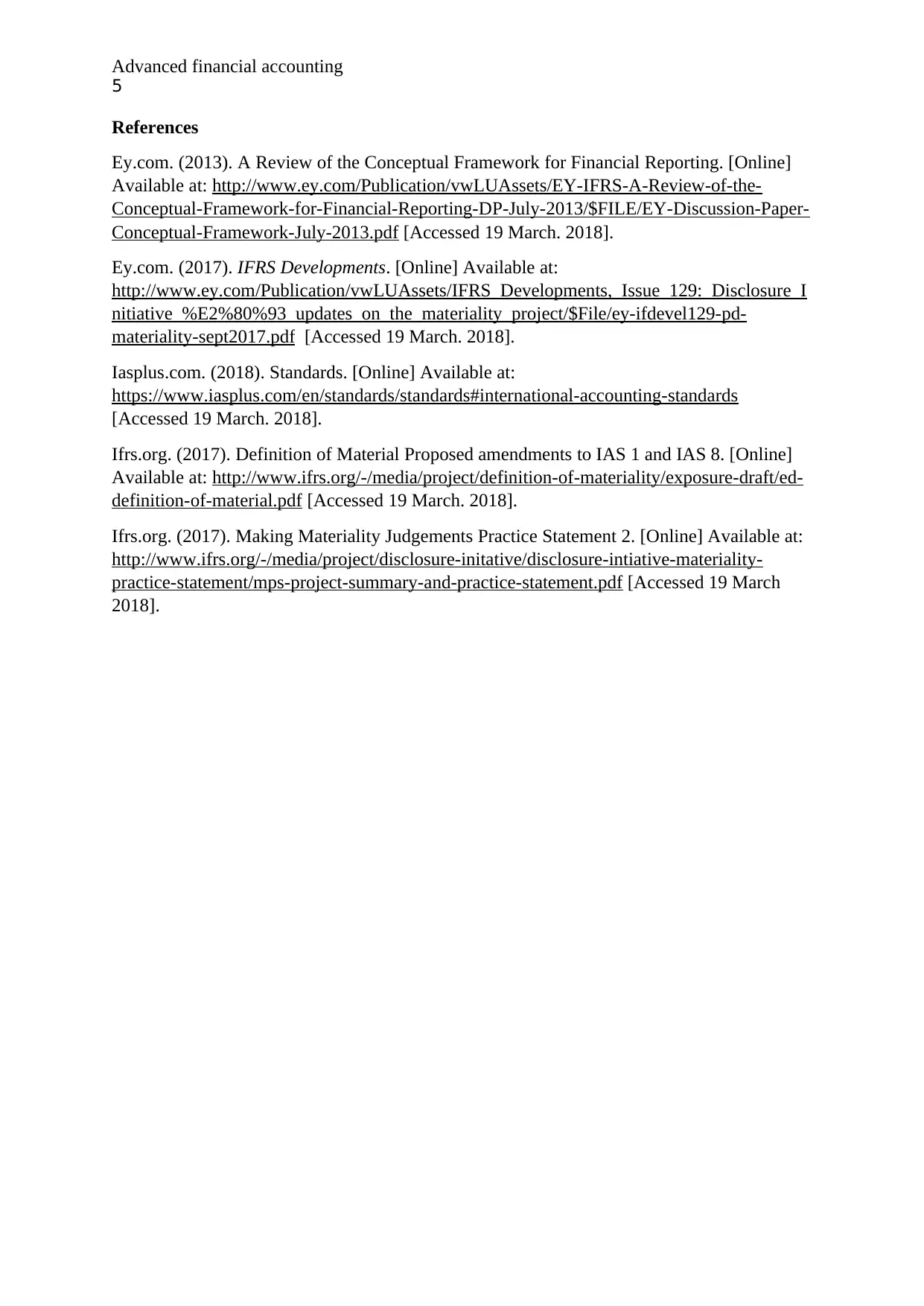
Advanced financial accounting
5
References
Ey.com. (2013). A Review of the Conceptual Framework for Financial Reporting. [Online]
Available at: http://www.ey.com/Publication/vwLUAssets/EY-IFRS-A-Review-of-the-
Conceptual-Framework-for-Financial-Reporting-DP-July-2013/$FILE/EY-Discussion-Paper-
Conceptual-Framework-July-2013.pdf [Accessed 19 March. 2018].
Ey.com. (2017). IFRS Developments. [Online] Available at:
http://www.ey.com/Publication/vwLUAssets/IFRS_Developments,_Issue_129:_Disclosure_I
nitiative_%E2%80%93_updates_on_the_materiality_project/$File/ey-ifdevel129-pd-
materiality-sept2017.pdf [Accessed 19 March. 2018].
Iasplus.com. (2018). Standards. [Online] Available at:
https://www.iasplus.com/en/standards/standards#international-accounting-standards
[Accessed 19 March. 2018].
Ifrs.org. (2017). Definition of Material Proposed amendments to IAS 1 and IAS 8. [Online]
Available at: http://www.ifrs.org/-/media/project/definition-of-materiality/exposure-draft/ed-
definition-of-material.pdf [Accessed 19 March. 2018].
Ifrs.org. (2017). Making Materiality Judgements Practice Statement 2. [Online] Available at:
http://www.ifrs.org/-/media/project/disclosure-initative/disclosure-intiative-materiality-
practice-statement/mps-project-summary-and-practice-statement.pdf [Accessed 19 March
2018].
5
References
Ey.com. (2013). A Review of the Conceptual Framework for Financial Reporting. [Online]
Available at: http://www.ey.com/Publication/vwLUAssets/EY-IFRS-A-Review-of-the-
Conceptual-Framework-for-Financial-Reporting-DP-July-2013/$FILE/EY-Discussion-Paper-
Conceptual-Framework-July-2013.pdf [Accessed 19 March. 2018].
Ey.com. (2017). IFRS Developments. [Online] Available at:
http://www.ey.com/Publication/vwLUAssets/IFRS_Developments,_Issue_129:_Disclosure_I
nitiative_%E2%80%93_updates_on_the_materiality_project/$File/ey-ifdevel129-pd-
materiality-sept2017.pdf [Accessed 19 March. 2018].
Iasplus.com. (2018). Standards. [Online] Available at:
https://www.iasplus.com/en/standards/standards#international-accounting-standards
[Accessed 19 March. 2018].
Ifrs.org. (2017). Definition of Material Proposed amendments to IAS 1 and IAS 8. [Online]
Available at: http://www.ifrs.org/-/media/project/definition-of-materiality/exposure-draft/ed-
definition-of-material.pdf [Accessed 19 March. 2018].
Ifrs.org. (2017). Making Materiality Judgements Practice Statement 2. [Online] Available at:
http://www.ifrs.org/-/media/project/disclosure-initative/disclosure-intiative-materiality-
practice-statement/mps-project-summary-and-practice-statement.pdf [Accessed 19 March
2018].
⊘ This is a preview!⊘
Do you want full access?
Subscribe today to unlock all pages.

Trusted by 1+ million students worldwide
1 out of 6
Related Documents
Your All-in-One AI-Powered Toolkit for Academic Success.
+13062052269
info@desklib.com
Available 24*7 on WhatsApp / Email
![[object Object]](/_next/static/media/star-bottom.7253800d.svg)
Unlock your academic potential
Copyright © 2020–2025 A2Z Services. All Rights Reserved. Developed and managed by ZUCOL.





